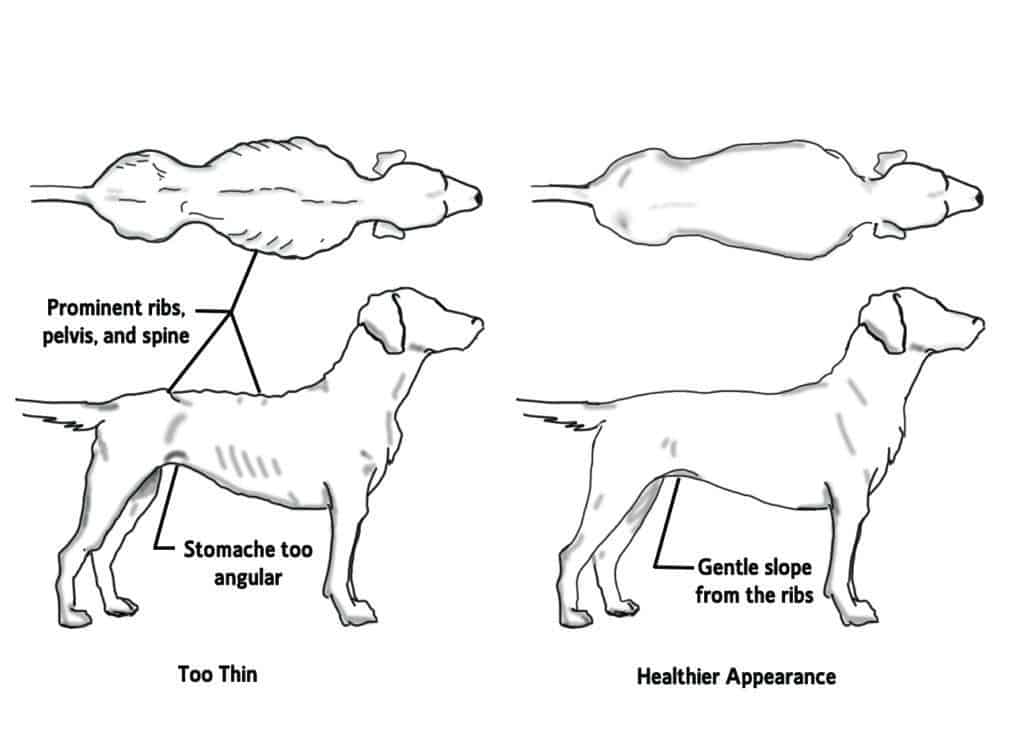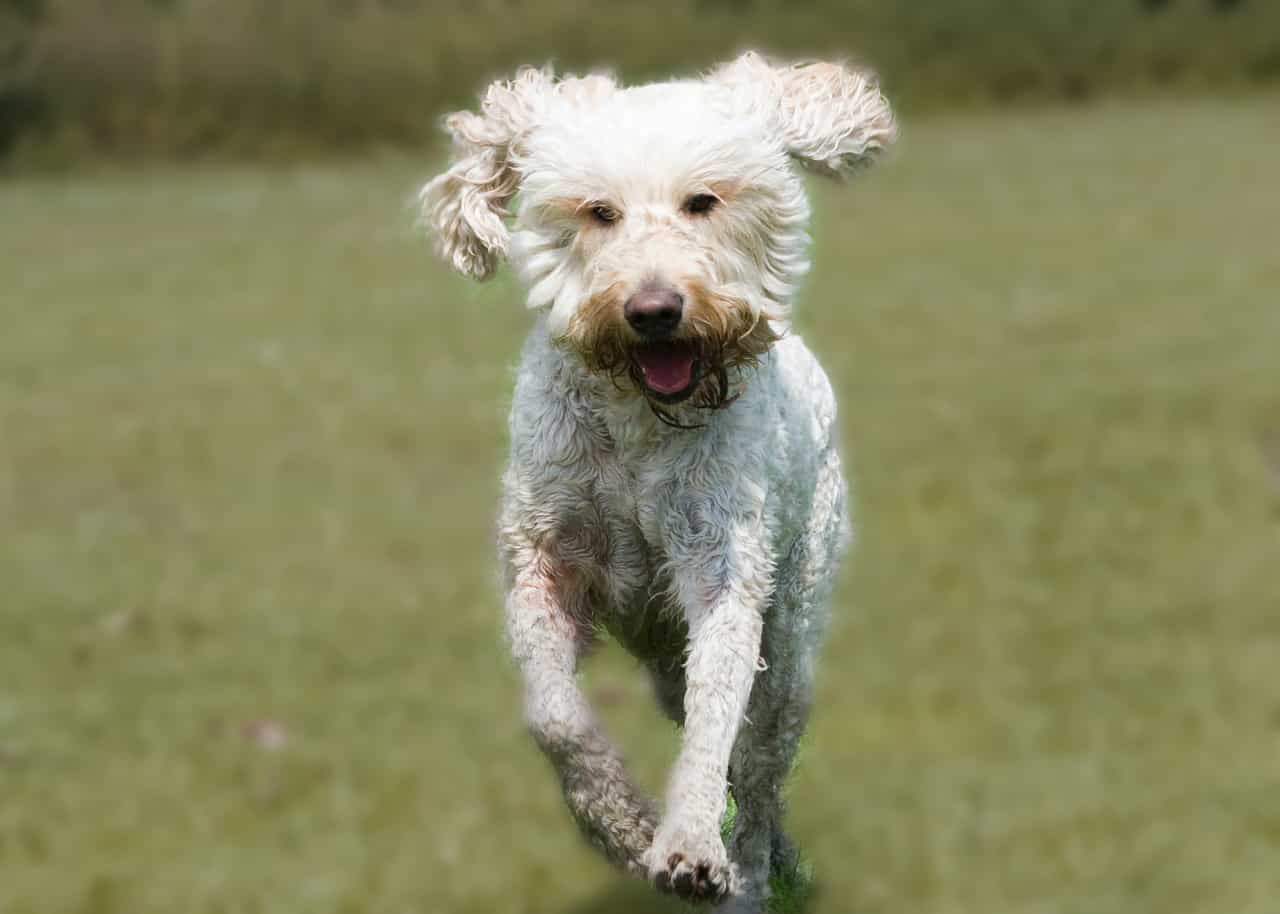Is Your Goldendoodle Too Skinny?
Have you noticed that your Goldendoodle seems a bit lanky or skinny compared to other dogs, and you’re worried that there might be a medical problem present? Since Goldendoodles will eat anything that even resembles food, you sometimes can’t tell if he is starving or just being a Goldendoodle. You can evaluate your own pet to determine if he’s getting enough nutrition.
The Golden retriever and the standard poodle are both intelligent dogs. They are also very friendly and hypoallergenic. They make great pets for families and their health problems are few and far between.
The growth pattern will differ from dog to dog, but there are some guidelines that you may find helpful. Because Golden Doodle puppies are a mixed popular breed, it is sometimes difficult to calculate their growth rate.
Is your Goldendoodle too skinny? Lightly run your hand along his chest and you should be able to feel ribs just under a very thin layer of fat when gently running your hands over the rib area. You should, however, not see his ribs from above or the side.
- Visual Evaluation
- How To Weigh Your Goldendoodle
- How Much Should My Goldendoodle Weigh?
- How Much Food Should I Be Feeding My Goldendoodle?
- Miniature Goldendoodle Approximate Weights
- Medium Goldendoodle Approximate Weights
- Standard Goldendoodle Approximate Weights
- Goldendoodle’s Possible Health Issues
- What Should You Feed Your Goldendoodle?
Visual Evaluation
Stand behind your dog and look down at his body. The waist will curve inward gradually from his ribcage if he is a healthy weight. Underweight adult size dogs will have pronounced waistlines. If your Goldendoodle has a short haircut, you should not be able to see the spine. Run your hand along the spine and see if it feels too close to the surface. Continue running your hand to the pelvic bone. If your dog’s vertebrae and pelvis are too conspicuous, he is probably underweight.
This examination will be a bit more difficult to do on smaller breeds such as mini Goldendoodles. Mini Goldendoodles have a more compact body and the spine and ribs will not be as prominent as they would be on a larger breed.
Note the appearance of his abdomen from the side. The abdomen should slope gradually upward from his ribcage, and not be angular to the hips. Your dog should have a healthy thin layer of fat and display a muscular appearance.
Your dog’s coat should be healthy and with a nice sheen. If it is dry and brittle then you might have a nutritional deficiency. Consult with your vet to see if your dog needs to be on any supplements.

How To Weigh Your Goldendoodle
As your puppy begins his growth spurt, you will want to keep a close eye on his or her development of the first few weeks and months by weighing your doodle regularly during the first year of life.
You can use a regular bathroom scale to measure your doodle’s weight by picking up the puppy and while holding it close to your body step on the scale and record the number. You then put the puppy down and weigh yourself without the dog and subtract that number from the first measurement. This will give you your puppy’s exact weight.
How Much Should My Goldendoodle Weigh?
Since a litter of puppies has larger and smaller (the runt) siblings, it is difficult to say what the birth weight should be, but after a few weeks of life, they begin to average out. Our charts below are for an approximate weight after x months of life. Every mixed breed Goldendoodle is unique in its physical attributes, but an average adult weight for your furry companion is as follows: Toy Goldendoodles – 10-15 lbs. (Toy Poodle as one parent)
Miniature Goldendoodles – 15-30 lbs.
Medium Goldendoodles – 30-45 lbs.
Standard Goldendoodles – 45 + (Adult Size Avg 60-80 lbs.) Goldendoodles typically reach their maximum height by about one year old but can continue to grow for a little longer. Their growth cycle usually finishes anywhere between 1-2 years of age.
How Much Food Should I Be Feeding My Goldendoodle?
Below is a listing of what your Goldendoodle on average should be fed considering his size and age.
| Dogs Weight | Less Active | Active | Puppy |
|---|---|---|---|
| 2 - 5 lb | 110-220 Cal | 150-280 Cal | 170-335 Cal |
| 5 - 10 lb | 225-335 Cal | 228-450 Cal | 335-560 Cal |
| 10 - 20 lb | 335-450 Cal | 450-560 Cal | 560-675 Cal |
| 20 - 30 lb | 450-675 Cal | 560-785 Cal | 675- 900 Cal |
| 30 - 50 lb | 675- 900 Cal | 785-1,015 Cal | 900-1,235 Cal |
| 50 - 70 lb | 900-1,125 Cal | 1,015-1,465 Cal | 1,235-1,690 Cal |
| 70 - 90 lb | 1,125-1,350 Cal | 1,465-1,575 Cal | 1,690-1,915 Cal |
| 90 - 110 lb | 1,350-1,575 Cal | 1,575-1,860 Cal | 1,915-2,365 Cal |
| 110 - 140 lb | 1,575-1,800 Cal | 1,860-2,140 Cal | 2,365-2,590 Cal |
Miniature Goldendoodle Approximate Weights
| Age | Weight |
|---|---|
| 2 months old | 10 lbs. |
| 3 months old | 12 lbs. |
| 4 months old | 17 lbs. |
| 5 months old | 20 lbs. |
| 6 months old | 23 lbs. |
| 7 months old | 25 lbs. |
| 8 months old | 27 lbs. |
| 9 months old | 29 lbs. |
| 10 months old | 30 lbs. |
| 11 months old | 30 lbs. |
| 12 months old | 30 lbs. |
Medium Goldendoodle Approximate Weights
| Age | Weight |
|---|---|
| 2 months old | 14 lbs. |
| 3 months old | 20 lbs. |
| 4 months old | 24 lbs. |
| 5 months old | 29 lbs. |
| 6 months old | 33 lbs. |
| 7 months old | 36 lbs. |
| 8 months old | 40 lbs. |
| 9 months old | 42 lbs. |
| 10 months old | 43 lbs. |
| 11 months old | 44 lbs. |
| 12 months old | 45 lbs. |
Standard Goldendoodle Approximate Weights
| Age | Weight |
|---|---|
| 2 months old | 21 lbs. |
| 3 months old | 25 lbs. |
| 4 months old | 35 lbs. |
| 5 months old | 40 lbs. |
| 6 months old | 45 lbs. |
| 7 months old | 49 lbs. |
| 8 months old | 52 lbs. |
| 9 months old | 55 lbs. |
| 10 months old | 56 lbs. |
| 11 months old | 58 lbs. |
| 12 months old | 58 lbs. |
Your standard Goldendoodle puppy should weigh around 50 pounds at the halfway mark of 7 months of age and grow to an average weight of 55 pounds by 9 months.
By the time your standard Goldendoodle puppy is 12 weeks of age, he should weigh about 30 pounds. Keep your dog on an upward growth curve to ensure he is healthy.
Goldendoodle’s Possible Health Issues
If your Goldendoodle is getting the proper nutrition and has inherited the legendary appetite from the If your Goldendoodle is getting the proper nutrition and has inherited the legendary appetite from the Golden Retriever parent, then there might be a physiological condition lurking in the background. Possible health issues to be concerned about are:
- Diabetes
- Cushing’s Disease
- Parasites (such as worms)
- Cancers
- Digestive disorders
Improper nutrition can also be the CAUSE of a multitude of health problems in hybrid breeds such as:
- Hip Dysplasia
- Kidney disease
- Heart disease
- Liver disease
- Skin diseases
- Eye diseases
- Problems with urination
- Allergies
- Hair loss
- Infections
- Dental problems
- Behavioral problems
- Aging
It is important to note that many of these conditions can be prevented by regular veterinary care and proper diet. Your veterinarian should be consulted so you can rule out any health issues.
What Should You Feed Your Goldendoodle?
A good reference for Goldendoodle nutritional chow can be found at Dog Food Guide. It ranks food for your Goldendoodle based on quality and affordability.
It ranks food for your Goldendoodle based on quality and affordability. There are many different types of adult dog food available, including dry, canned, frozen, raw meat diets, and others. Dry dog food is usually made from grains such as corn or wheat, while wet dog food may contain fish, chicken, lamb, beef, turkey, rice, oats.
The best dog food for a Goldendoodle depends on the age of your dog because Goldendoodle puppies, adults, and seniors each have different nutritional needs.
If you have a doodle that is a picky eater you might not want to change meals abruptly. This can cause stomach upset and a whole list of behavior problems you don’t want to get into. If your dog has to be bribed to eat, then he probably just doesn’t like the food he’s being given. Many Goldendoodle owners have found that adding a “surf and turf” type of food keeps their dogs eating their protein consistently. I guess because it’s so stinky that they love to eat it, and it is higher in calories in most cases. You should certainly try it and see if this gives the needed encouragement to eat what they are given.
You should also make sure that your dog gets enough exercise. A healthy dog needs at least 30 minutes of daily playtime and walks. The more active your dog is, the healthier he will be. And…it is important for your dog to have regular checkups with his veterinarian. This way, you can catch any issues early on before they become serious.
After everything is said and done your dog’s health is most important and you want to build lean muscle mass and avoid too much of the fat layer. Many dog owners have discovered that after their puppy has been to the groomers and been shorn, the dog looks shockingly skinny. This is when you should begin the visual inspection to see if he or she is too skinny. If your dog is eating normally and it’s still skin and bones, it’s time to visit the vet.


